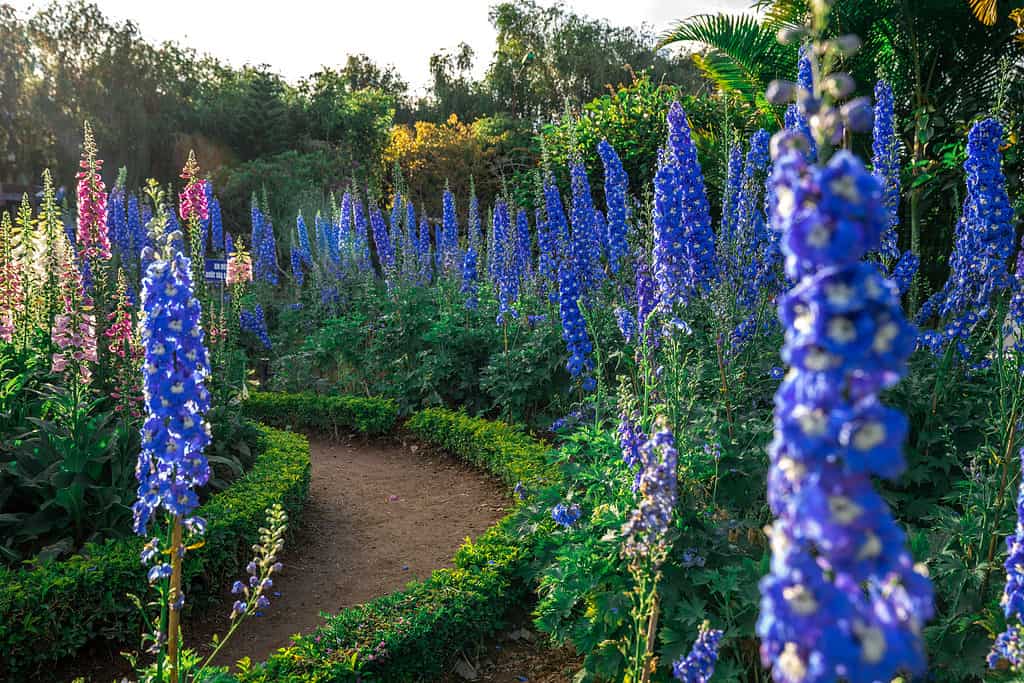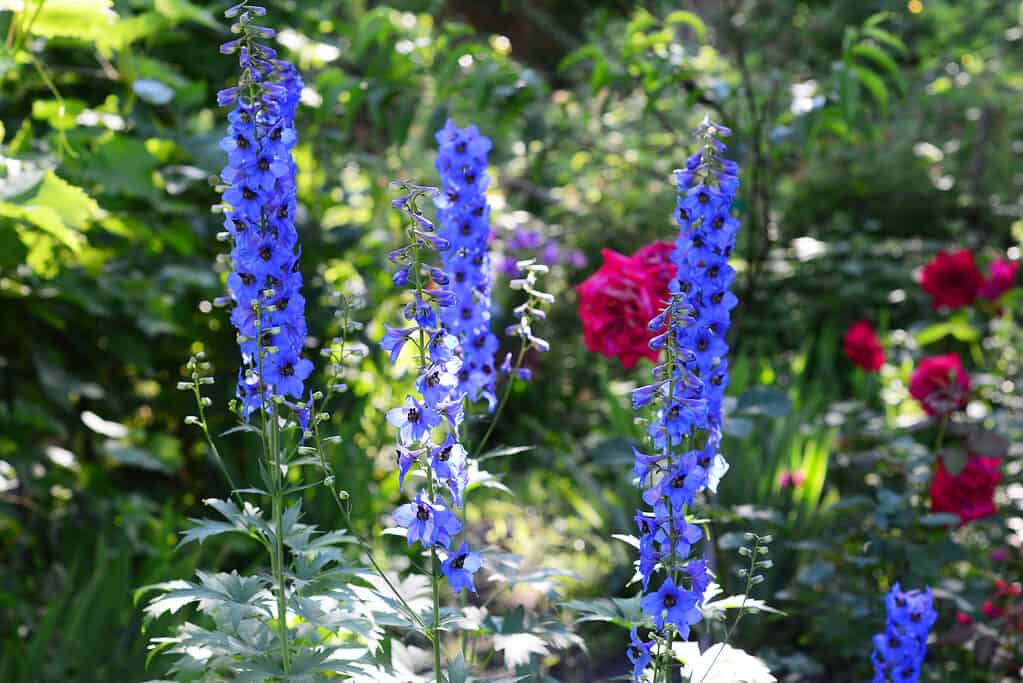While people may compare larkspur vs. delphinium, the truth is that larkspur is actually the common name for the genus, Delphinium.
Therefore, in this guide, we’ll discuss the misinformation around this genus of flowering plants, and provide accurate info about its plant classification, physical characteristics, native range and ideal growing conditions.
So, without further ado, let’s jump in!
Plant Classification: What Are Larkspurs?
Normally, common names describe a specific species or genus, like how Dutchman’s breeches is the common name for Dicentra cucullaria. However, the common name Larkspur actually describes two genera of flowering plants in the Ranunculaceae family, Delphinium and Consolida. While Consolida contains about 40 species, the much larger genus, Delphinium, comprises over 500 species of flowering plants. So, while all delphiniums are larkspurs, not all larkspurs are delphiniums. In this guide, we’ll focus on the much larger genus of Delphinium.

©Chanon Vathanopas/Shutterstock.com
Larkspur vs. Delphinium: Physical Characteristics
Now that you know when comparing larkspur vs. Delphinium that Delphinium are larkspurs, we’ll dig into the physical characteristics of this genus of lovely flowers. Most delphiniums grow between 1 to 3 feet high, but some species can reach up to 8 feet tall. The leaves of delphiniums are always alternately arranged and compound though they can differ in whether they are palmate, bipinnate, or pinnate.
Additionally, the leaves tend to be lacy or fern-like and are of ornamental interest in gardens. The plants can be perennials, annuals, or biennials and the flowers can be blue, pink, white, purple, or lavender. The flowers are a high point of interest and are typically showy and arranged in clusters along an upright stalk.

©Lois GoBe/Shutterstock.com
Native Range and Ideal Growing Conditions
Containing over 500 species, the genus of Delphinium has species native to temperate Asia, Europe, North America, and some mountainous regions of Africa. An example of a Delphinium native to North America is Delphinium exaltatum (also known as tall larkspur). Tall larkspur’s native range stretches across the Appalachian mountains, west into the Ozarks, and as far south as Northern Alabama. As its common name suggests, this Delphinium species can grow 4-6 feet high. It produces stunning blue flowers and is a well-loved wildflower across its native growing region.
Depending on the species, delphiniums can grow in full sun to partial shade. They typically prefer to grow in fertile, well-draining, slightly alkaline soil. Most delphiniums can thrive in USDA Hardiness Zones 3b-9a. Many species of Delphinium don’t tolerate intense heat and prefer cooler summers. This genus of plants does not tolerate soggy roots well, and can be susceptible to root rot.
Regarding pollination, the vivid flowers of these plants attract many pollinators such as hummingbirds and butterflies.

©iStock.com/Lex20
Toxicity Notes
While delphiniums are wonderful to look at, all delphinium flowers are toxic to humans, cats, dogs, and horses. Poison severity to humans is rather high and can result in a range of serious symptoms, including burning mouth, numb throat, serious vomiting and GI symptoms, muscular weakness and spasms, seizures, weak pulse, and paralysis of the respiratory system. Some cases of poisoning can result in death from cardiac arrest or paralysis of the respiratory system.
The poisonous compounds in delphiniums include delphinine, a toxic crystalline alkaloid. So, if you’re walking amidst a beautiful garden of these lovely flowers, just remember to enjoy but not ingest!
Landscape Uses and Growing Tips
Delphiniums are widely popular in temperate gardens around the world for their stunning flowers that grow in lovely clusters along their upright stalks. Particularly, many people enjoy planting delphiniums with blue flowers in their gardens, as blue-flowered plants are fairly rare. These flowers provide gorgeous pops of color from early to mid-Summer, and often flower again early Fall. Delphiniums are often planted in cottage gardens and as border plants. They typically look best planted in groups where their flower-covered stalks create a sea of colors.
Gardeners should plant delphiniums in sheltered locations as heavy rain and winds can damage their delicate flowers and upright stalks. Indeed, wild delphiniums often grow in semi-wooded areas where they receive shelter from trees during storms. While growing these gorgeous flowers is extremely rewarding, delphiniums are not considered low-maintenance plants. Often, they require frequent pruning, dead-heading, staking for taller varieties, and disease control.
Unfortunately, these plants are susceptible to several diseases such as powdery mildew, leaf spots, botrytis blight, and crown rot. Gardeners can avoid mildew problems by planting their delphiniums in full sun with plentiful air flow. They can also make sure to only water plants at the base to avoid over-wetting the leaves.
Up Next
The post Larkspur vs. Delphinium appeared first on AZ Animals.
from Animal News, Facts, Rankings, and More! - AZ Animals https://ift.tt/dchXtUS